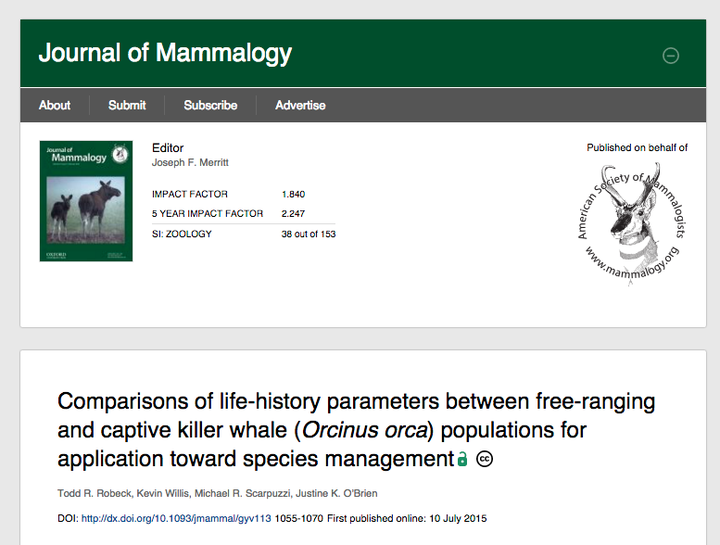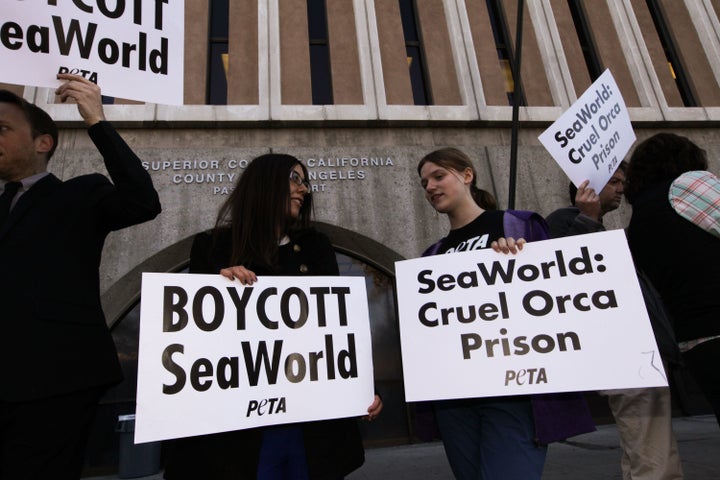
SeaWorld has continued to use “misleading” statistics on the life expectancy of captive orcas, according to experts, even as one of its own nears death.
The American amusement park admitted this week that Tilikum, housed at its Orlando attraction and the subject of emotive documentary, ‘Blackfish’, is suffering from a chronic lung disease.
Tilikum, who was not born at or collected by SeaWorld, came to his current home from a park called Sealand, on Canada’s Pacific coast.
SeaWorld said: “Based on his size at collection in 1983, we estimate that he is about 35 years old, which is near the high end of the average life expectancy for male killer whales.”

SeaWorld says it hasn't collected a whale from the wild in 35 years.
The firm said that since Tilikum arrived at the park 23 years ago, he has received the "best in marine mammal health care and life enrichment available for killer whales," but that he's suffering illness as he ages.
“Despite the best care available, like all aging animals, he battles chronic health issues that are taking a greater toll as he ages.”
- SeaWorld
But a peer-reviewed study used to strengthen SeaWorld's claims that the orca had reached "the high end of the average life expectancy for male killer whales", has been slammed by an expert.
Dr Trevor Willis, a senior lecturer in marine biology at the University of Portsmouth, described SeaWorld’s cited source as “clearly wrong” and indicative of “poor practice”.
He told The Huffington Post UK that the September 2015 study published in the Journal of Mammalogy was "more than a little misleading".

Dr Willis said: “First, it compares two entirely different circumstances: the controlled environment of a swimming pool, with highly-trained vets on hand; and the wild ocean.
“There are no predators in a swimming pool.
“Second, and in the absence of any other information, it appears they’ve looked at the survival rate of calves in the first two years of life and extrapolated it out 50 years into the future.

Dr Willis continued: “The way you know this study isn’t right is by looking at the recorded average life expectancy of adult orcas at SeaWorld – it’s 55.8 years.
“No captive orca has lived that long.
“Trying to predict adult mortality based on the daily survival rate of calves is more than a little misleading.
“It’s fairly poor practice to extend the data so far into the future – it’s called extrapolating beyond the data. It’s clearly wrong.
“They should compare apples with apples and look only at adult animals.”

In a further blow to the source's legitimacy, its lead author, Todd Robeck, is SeaWorld’s own vice-president of theriogenology, in charge of breeding the park's animals.
Yet this isn’t the first time SeaWorld’s claims about orca life expectancy have been criticised.
The 2013 documentary ‘Blackfish’ highlighted the debate around the firm's use of statistics on orca life spans.

“Because the whales in their pools die young, they like to say that all orcas die at 25 to 30 years,” Howard Garrett, an orca researcher told the film.
‘Blackfish’ showed clips of SeaWorld multiple trainers and tour guides reiterating the belief that orcas live to between 25 and 35 years to visitors to the park on numerous occasions.
Garrett continued: “Of course that’s false, we knew that by 1980 after half a dozen years of the research, they live to human life spans.”
Sam Lipman, founder of campaign group Orca Aware, told HuffPost UK that SeaWorld refuse to accept the truth about orca life spans.
She said: "SeaWorld sometimes argue you cannot measure life expectancy of captive whales.
"What they won't say is that there's many, many cases where orcas live to 50, 60 years for males, and much longer for females.
"Tilikum is certainly nowhere near the longevity he could have achieved."

A spokesperson for PETA, the animal rights group leading a campaign against SeaWorld, told HuffPost UK: "Every single orca who has died at SeaWorld did so far short of how long they were expected to live.
"Even though, in reality, it's hard to call it "living" when their "lives" consist of being forced to perform circus-style tricks in a tiny concrete tank.
"A recent independent study found significantly lower average longevity among orcas in captivity. SeaWorld's claims simply don't hold water.
"If Tilikum never sees the ocean again, after being stolen from it 30 years ago, his blood will be on SeaWorld's hands and the concrete walls of his miserable prison tank."

A spokesperson for SeaWorld told HuffPost UK in an email: "It’s a complex issue, and the issue of killer whale lifespan is one that is often misconstrued and overly simplified."
The firm said other marine biologists had found orca survival in the wild to be comparable with those in captivity.
SeaWorld’s latest update on Tilikum’s health was made on its blog and YouTube on Tuesday.
In an emotionally-charged video, one of the firm's veterinarians said: "Some of the issues we're continuing to deal with are [Tilikum's] chronic teeth issues, and one of the most concerning is what we believe to be a respiratory issue that is extremely difficult to treat."
Holding back tears, the vet added: "I wish I could say I was tremendously optimistic about Tilikum and his future, but he has a disease which is chronic and progressive, and at some point might cause his death.
"We have not found a cure for this disease at this point."
The park's head trainer said: "He's getting older, and what I know is that every day that I'm here and every day these amazing vetenarians are here he will receive the best care."
Tilikum's life in captivity has been controversial. The orca has been implicated in three deaths, including the horrific killing of trainer Dawn Brancheau in front of terrified SeaWorld guests in 2010.
